Add Nintex RPA Task step
Use the Add Nintex RPA Task step to start a Nintex RPA task in your workflow. For example, when an email is received, the task step will run to start the bot task in Nintex RPA.
Drag the Add Nintex RPA Task step from the Nintex RPA category, Favorites bar, or the Recent category onto the canvas.
Example of an Add Nintex RPA Task step in a workflow
- From the Toolbox click the Nintex RPA category, and then drag the Add Nintex RPA Task step onto the canvas.
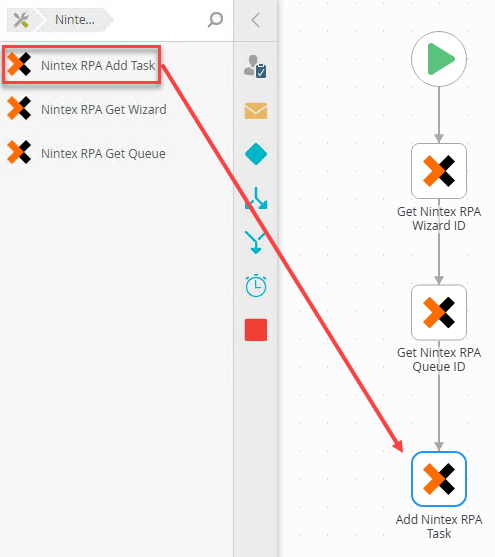
- Select the added step and click the expand / collapse toggle to expand the Configuration Panel. You can also double click the step to expand the panel.
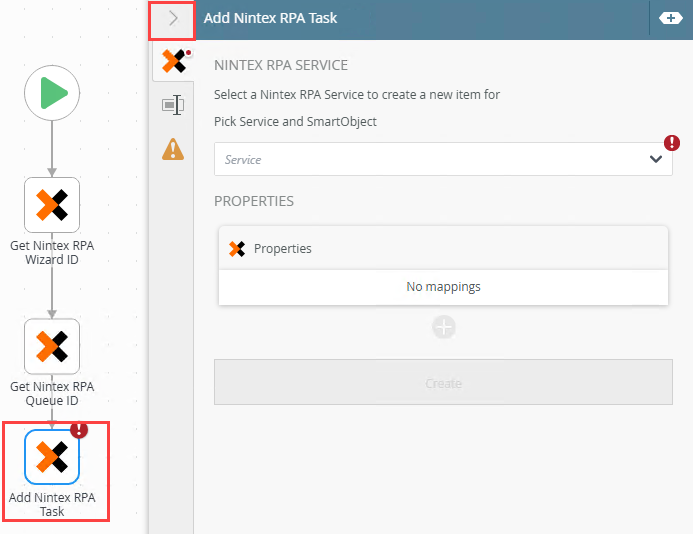
- Select the Nintex RPAService tab. Use this tab to configure the task properties.
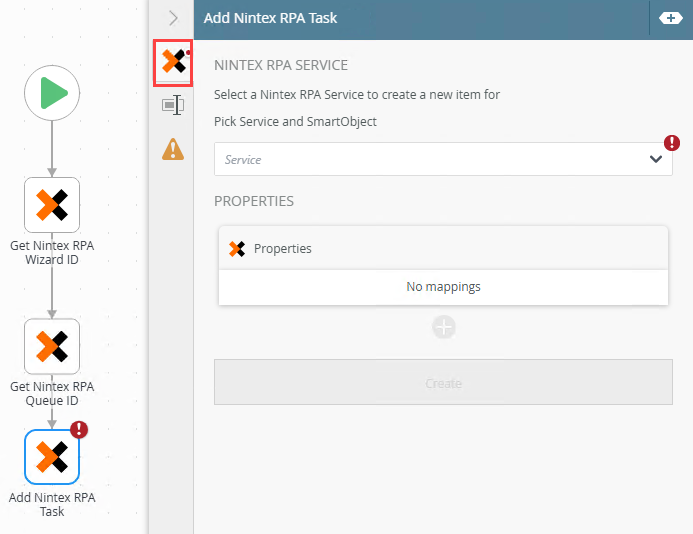
- From the menu select Browse and navigate to the SmartObject.
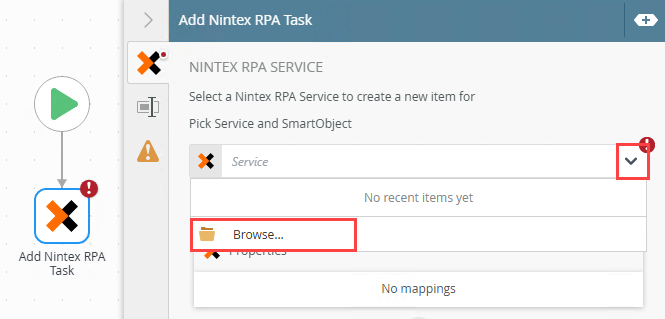
- Select the SmartObject and click OK.

- In the added property field, type a value, use inline functions, or dynamic fields, by clicking Add to expand the Context Browser. Within the Context Browser, select inline functions and fields from the
Functions,
Fields, SmartObjects and Workflow categories. Click and drag the function into the property field.

- To add additional properties, click Add.
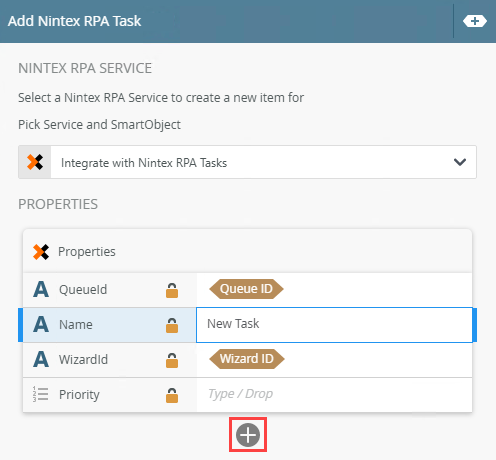
- To delete properties, select them and click the Trash bin.
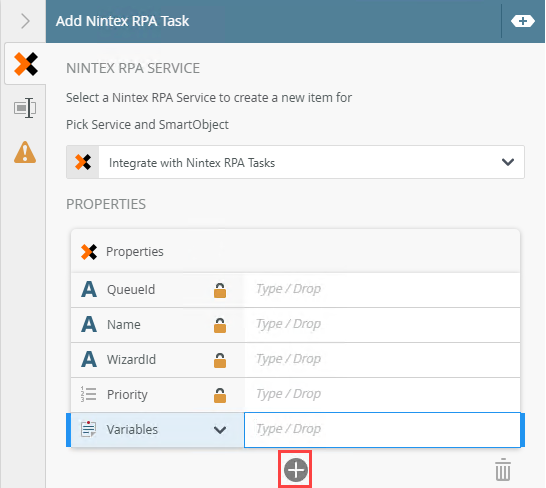
- With the step selected, select the Properties tab.
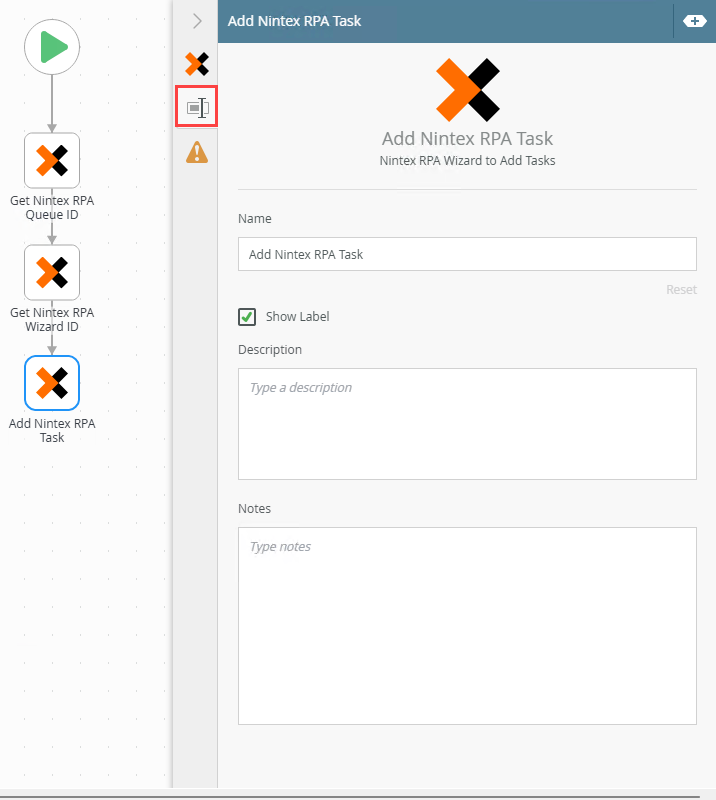
- Click the Errors tab.
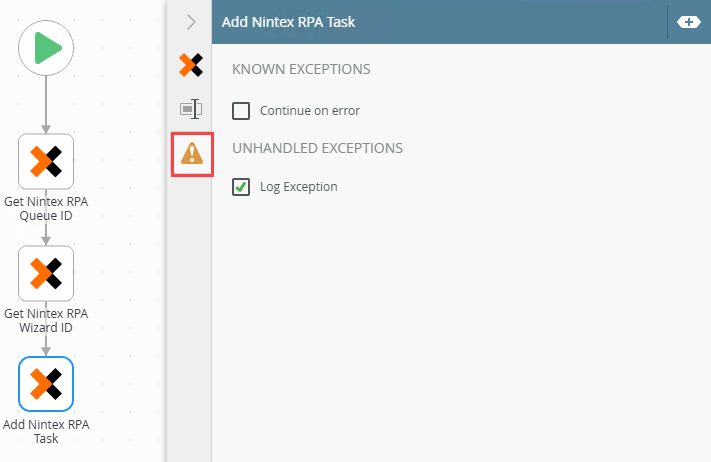
- The exceptions in the table above is an example of those available in Workflow steps. The exceptions available depend on the Workflow step used in the design canvas.
-
When you enable both Continue on Error and Force error when required SmartObject inputs are missing, the workflow continues with execution even if the required inputs are missing. The Continue on Error setting takes precedence.
-
Your changes are automatically saved.
The following table explains the available options:
| Option | Explanation | How to Use |
|---|---|---|
| Pick Service and SmartObject |
Use this to select the Nintex RPA SmartObject that is linked to your RPA server. This allows the step to link to the Wizard and Queue from the RPA server. |
Click the menu and click Browse to browse to a specific SmartObject. Click the edit button to make changes to the field. |
| Properties |
Use this to add properties such as the Wizard ID and Queue ID to ensure the correct bot task in run in RPA. Type values or create dynamic values by dragging Functions, Fields, SmartObjects and Workflow-related items from the Context Browser into the fields. |
Click the property field to add a value by typing or dragging it. Click the Add button to add the property field. To delete a property, select it and click the trash can. |
For more information about the different browse states and errors, see the Browse States topic.
For more information on how to use the breadcrumb bar, see the How to use the Breadcrumb topic.
For more information on how to use SmartFields, see the Smartfield Composer topic.
The following table explains the options available on this tab:
| Option | Explanation | How to Use |
|---|---|---|
| Title / Name | By default, each step on the canvas has a step title. You can change this title to suit your workflow logic and show it on the canvas by checking the Show Label box. | Enter a value into the Title/Name field. |
| Reset link | Use the link to reset any changes to the title. | Click the Reset link to reset the Title/Name field to default value. |
| Show Label | Allows you to see the step label on the canvas. The label shows the value of the title. | Check the check box to display step label on the canvas. |
| Description | Allows you to add a detailed description for the step. | Enter a value into the Create New field. |
| Notes | Allows you to add additional notes for the step. | Enter a value into the Notes field. |
Different types of exceptions can occur on a step, such as:
| Type | Description |
|---|---|
| Known exceptions | Any SmartWizard or standard wizard that has Boolean options for handling known exceptions have these options displayed as check boxes in the Known exceptions section of the Exceptions tab. |
| Unhandled exceptions | Any unknown runtime exceptions. |
The tab contains the following known exception:
| Exception | Explanation | How to Use |
|---|---|---|
| Continue on error | On step execution and an error occurs, continue to the next step in the workflow. | Check the check box to continue the workflow. |
The tab contains the following unhandled exceptions:
| Exception | Explanation |
|---|---|
| Log Exception | Logs the exception to the error log. |
| Force error when required SmartObject inputs are missing | Will forcefully throw an error if a SmartObject method has input missing. |
| Continue on error | Will force the workflow to continue running the SmartObject method, even if it runs into an error. |